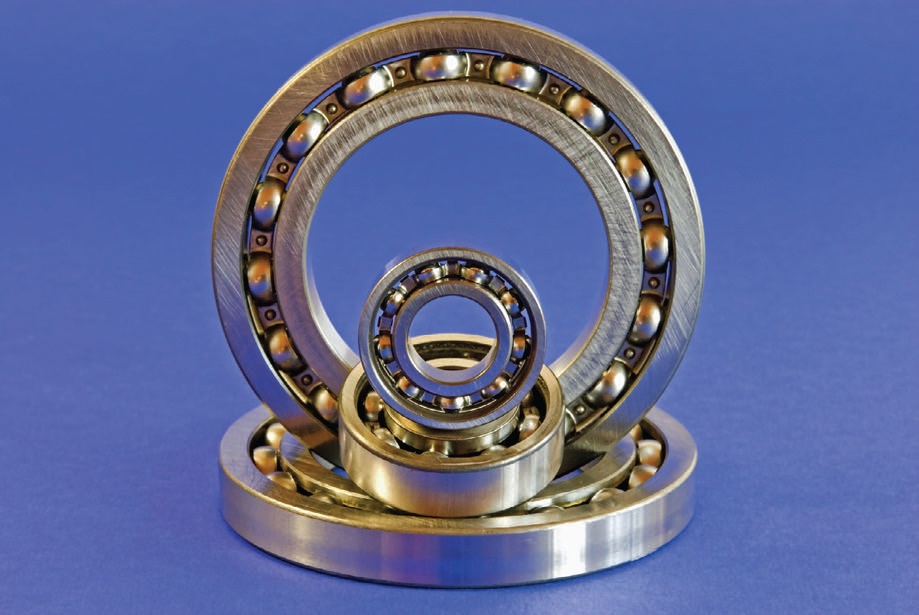Preventing bearing failures
R. David Whitby | TLT Worldwide January 2012
Use this eight-step analysis to detect problems early.

Inspection of a bearing is usually not enough to pinpoint the precise cause of damage.
www.canstockphoto.com
WHEN BALL OR ROLLER BEARINGS FAIL, machine downtime usually leads to high costs and lost production time. Fortunately, catastrophic failures of bearings are rare. Most often, distinct symptoms indicate that bearing damage occurs long before the bearing actually fails. More important, a methodology that addresses the symptoms of bearing damage should be implemented as soon as possible.
Experience has shown that damage to, and subsequent failure of, a bearing is seldom due to faults in the bearing. It is more often due to the treatment the bearing received or the use to which it was put.
The first sign of damage is frequently indicated by unusual operating behavior such as uneven running, reduced working accuracy, unusual running noises or any combination of the three. It is critical to record these early indicators, as information gained in this early period of degradation can be very useful in identifying the root cause of a problem. As a bearing becomes more damaged, root cause analysis becomes increasingly difficult.
The key to detecting early signs of a problem is effective condition monitoring. For many applications, monitoring by the machine operator is usually sufficient to detect unusual noises at an early stage. In situations where downtime is critical or hazardous, more formalized monitoring might be required, for example, assessing lubricant cleanliness and measuring bearing temperature and vibration analysis.
The type of condition monitoring used depends on the experience of previous failures and the production environment in which the bearing is used. Bearing damage can generally be classified as localized or widespread. The first is usually restricted to specific locations on the bearing. This can take the form of indentations caused by rolling elements, corrosion or fractures. It can be recognized most easily using a combination of vibration and lubricant monitoring. Vibration methods reliably detect fatigue damage at any early stage but are not suitable for detecting lubrication problems.
Widespread damage is often the result of an insufficient supply of clean lubricant. Failures of this type can be detected by monitoring the lubricant supply. Oil flow can be monitored for pressure, flow and cleanliness. A magnetic plug in the lubricant supply system gives a crude indication of lubricant condition, while a spectrophotometric or ferrographic analysis can be used to provide a more precise check.
Temperature can be monitored using thermocouples and gives a very reliable indicator of impending bearing problems. Normally a system reaches a steady-state temperature and shows a sudden rise when there is a lack of lubricant. The temperature typically rises unevenly over time if the grease is deteriorating.
When a damaged bearing has to be removed, the cause must be established to avoid future failures. Inspection of the bearing alone is not usually enough to pinpoint the precise cause of damage.
Following are eight systematic procedures for removing, securing and inspecting the bearing:
1.
Determine bearing operating data and check the bearing environment for external influences and other damage.
2.
Evaluate records and charts from any bearing-monitoring devices.
3.
Take lubricant samples.
4.
Assess the bearing in its mounted condition.
5.
Mark the mounting position and then dismount the bearing.
6.
Mark the bearing and its parts.
7.
Check the bearing seats.
8.
Assess the complete bearing.
This methodology is comprehensive, but its usefulness declines if the level of damage is excessive. The earlier a bearing can be dismounted, the more effective the assessment process. Examination of the failure mode can reveal the true cause of failure but can be complicated by the fact that one failure mode may initiate another.
 David Whitby is chief executive of Pathmaster Marketing Ltd. in Surrey, England. You can reach him at pathmaster.marketing@yahoo.co.uk
David Whitby is chief executive of Pathmaster Marketing Ltd. in Surrey, England. You can reach him at pathmaster.marketing@yahoo.co.uk.